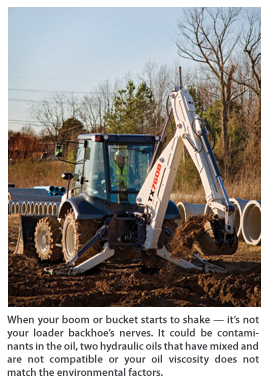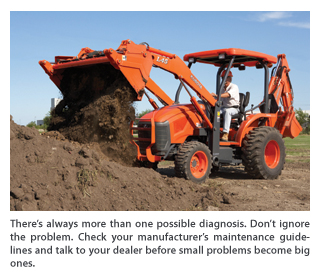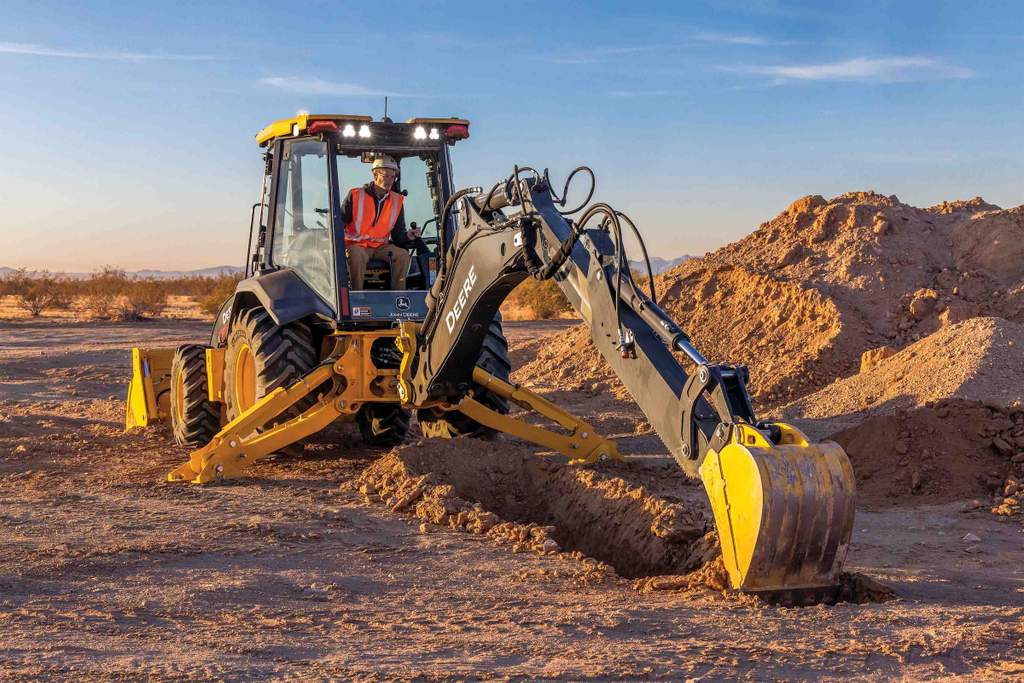Loader Backhoe Differential Diagnosis

Sitting in the waiting room, your leg bounces restlessly as your mind races. Those tremors…The shaking was unnatural. Something has to be wrong with her. You pick up a magazine to calm your nerves and flip through the pages to hide your wandering eye. A grizzled old timer, whose hands are bathed in dark oil, stares hopelessly into the floor. A young man holding a coiled mess of hoses and metal fights the fear of his first loss.
Just then your loyal mechanic — machine diagnostician and healer of productive iron — enters the room. With a smile, he explains that the jitters were just a gunked-up hydraulic line on the quick-coupler. And the smoke on startup? A blocked air filter. With a smile and handshake you thank the good machine doctor. You were lucky this time.

Cardiology
The engine is the heart of any machine and a cycle arrhythmia or painful-sounding noises can worry a loader backhoe operator. If there’s a problem, you might see symptoms as soon as you turn the key.
“An engine that does not want to start could have several different possible causes,” says Tim Boulds, Construction Equipment Product Manager for Kubota Tractor Corp. “There could be air in the fuel system lines, which would need to be bled. If you’re located in an area that experiences extreme cold temperatures, high viscosity of engine oil could result in a hard starting engine. Use of a block heater and/or oil pan heater would help to eliminate this issue.
If there is a compression leak due to a head gasket or worn piston and cylinder it would cause the engine to not want to start or be very hard to start. A failure in the engine such as seizure of the crankshaft, cam shaft, piston, cylinder or bearing will also cause the engine to be hard to start.”
The engine is a complex machine — supplying a steady stream of power to your machine. So there’s always more than one possible diagnosis. Don’t ignore the problem. If an engine turning over faster, it could be that there’s no fuel getting to the cylinders. A blocked fuel filter or even an empty fuel tank could be the culprit. Or, it could indicate that an electric fuel pump is working. If the engine is slow to turn over, it could be a bad battery or starter or that a cold-start device is not working, explains John Semosh, TCE Product Support Manager for Terex Construction Americas.
“During start up, the way the engine and injection pump are designed, the machine will send full [throttle] fuel to the engine for initial start up and then immediately regulate the fuel/air ratio back to the proper amount,” explains Boulds. “During this sequence the operator will see a small amount of black smoke come from the machine as it is started. This is normal.”
When smoke isn’t normal is after the engine has been running for a couple hours. This could mean that the piston rings are getting worn and need to be replaced. It can even result in bad turbo chargers or signal that you simply need a new air filter.
Depending upon the color of the smoke there could be different issues, according to Boulds. Black smoke typically means that the engine is not burning all of its fuel. The machine is running too lean (too much fuel, not enough air). This could be caused by a clogged air filter that’s not allowing enough air to enter. White smoke indicates the burning of water. This could be as simple as a damaged head gasket, but as serious as a cracked cylinder block. Blue smoke typically means that the engine is burning oil. One possible problem that causes this is the piston rings or cylinder walls are worn and allowing the engine oil to pass into the combustion chamber.
Visual problems are typically easy to spot, but you want to keep an ear out for problems too. This doesn’t mean you have to break out your stethoscope and closely monitor your engine’s sonic nuances. Just take note of anything out of the ordinary.
“An engine knock is always an indication of a problem,” says Semosh. “The ‘knock’ means that the engine has lost oil pressure. A pinging noise from the engine can indicate a fuel problem — either that the fuel in the tank is a very low grade or that it has water in it.
“To fix a low oil pressure issue, you will need to pull the engine out of the machine and replace the crankshaft bearings. If the issue is bad fuel or water in the fuel, you will have to drain the fuel tank, clean the fuel lines and then put new fuel in the machine.”
Of course the best treatment is preventative maintenance. Water in the tank, for example, can be avoided by filling the tank each night after running the equipment to keep condensation from forming in the tank, according to Semosh. Also before starting work each day, the operator should fill all of the main fluid levels — hydraulic oil, engine oil and fuel. Do a walk-around of the equipment, checking for damage from the previous day. This visual inspection should also include checking for leaks and making sure all the machine’s systems are lubricated and functioning properly. Have a grease gun handy for those squeaky bolts and zerks.
Circulatory System
The loader backhoes’ hydraulic lines carry the dark lifeblood of oils and fluids to the machine’s hard-working extremities. You want to keep your hoses clean and clear. Many problems can be avoided if operators simply take 15 minutes before start up, each day, to check the oils and general condition of the machine. This means inspecting for loose or missing nuts and bolts, greasing all the lube points and, of course, kicking the tires.

You can keep your hoses clean and filled with the proper oil, but sometimes things go wrong. When preventative maintenance fails, your loader backhoe PhD can come in handy.
“The most common way that the hydraulic lines become damaged is from the hoses rubbing against another object,”
Semosh says. “This indicates that the clamps that hold the hoses in place were not installed correctly [this issue often occurs when hoses are replaced]. To prevent this, two wrenches should be used when tightening a hydraulic hose, which minimizes the chance of the hose turning and laying correctly and reduces the cause of the rub.”
Contaminants in the lines can also be a problem.
Quick couplers in the circuit can allow entry of contaminants, says Boulds. Keep couplers clean by installing their covers or protective caps. Wipe the coupler surfaces clean before attaching together. And following the manufacturer’s filter and oil maintenance schedule helps to maintain clean, cool hydraulic oil. When adding fluid to the system, the lines are open to contamination, allowing dirt or small partials to work into the system and can cause valve spools to stick, which could cause jittery or erratic movement.
When your boom or bucket starts to shake — it’s not your loader backhoe’s nerves. It could be the aforementioned contaminants or two hydraulic oils that have mixed and are not compatible. So be sure that you’re filling your machine with manufacturer-recommended oil. If you used the same oil as last time, it could be that your oil viscosity does not match the environmental factors. If your lines are clogged, the fix might be to replace your culprit hoses.
When you replace any hose, be sure to follow the manufacturer’s guidelines and ensure that you clamp the hoses in tightly. A high-pitch whining sound can mean that the clamps are loose, which would let in contaminants and start the entire maintenance/problem circle all over again.
Motor Functions
From the first day you take your loader backhoe out for a spin, you depend on its powerful drive functions. Typically, the transmission won’t give you too many problems, according to Semosh. “If a problem does occur, the operator will usually hear a whine or vibration in one of the gear ranges the problem is in. This typically indicates that a bearing has gone bad on one of the shafts,” he says.

“A hard shifting transmission may lead to the actual shift fork itself being bent because the operator forces the machine into gear,” says Boulds. “Or, the linkage could be rusted and causing the machine to shift hard between gears. For hydrostatic drive transmissions, a loud squealing noise can possibly mean insufficient hydraulic transmission oil — its level is too low. The machine might not want to pull itself if the oil level is considerably low.”
Just before you leave the mechanic’s emergency room, he produces a small pad from his pocket and quickly jots down a prescription. It’s ripped routinely from the pad.
“Follow the manufacturer’s recommended maintenance intervals without fail.” You smile and thank him again for his help and expertise. You know that if you don’t heed his advice, next time the prognosis could be negative. But with your new found wisdom and a watchful eye (and ear), you’ll be prepared to tackle nearly any loader backhoe ailment like a true digging diagnostician.
Jason Morgan is Associate Editor of Utility Contractor.





Comments are closed here.